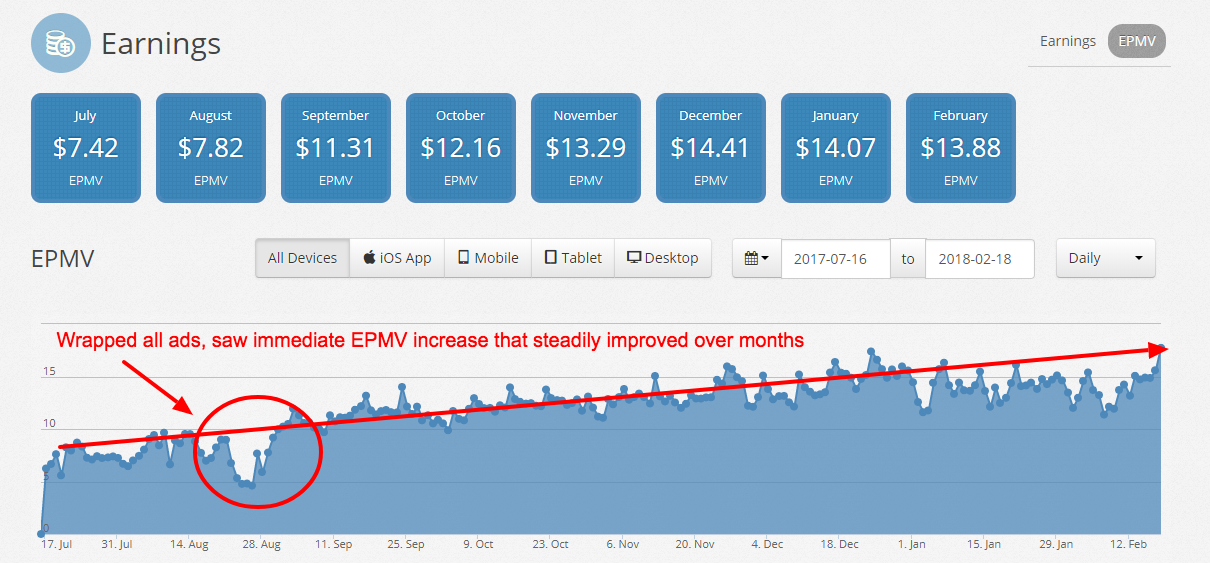Wrapping your existing ads during the EzoicAds setup process is crucial for Ezoic’s system to include them in optimization and testing. When ads are not wrapped, they appear in both the original and Ezoic versions of the site, but Ezoic cannot track their performance, which may lead to inaccurate revenue calculations and issues related to ad density.
Unwrapped ads can negatively impact the overall ad performance and user experience, potentially lowering the value of other ads on the page. This is because an individual ad on a page can actually reduce the value of the other ads on the page - sometimes markedly so. This could be either through increasing the bounce rate (through reduced UX) or by discouraging advertisers from bidding for other ad slots on the site.
One of the most important things Ezoic does is learn from visitor behavior and visitor engagement over time. If certain variables are missing, like ads that aren't being accounted for, Ezoic is learning without sufficient info and cannot make all the right decisions.
Ezoic's AI helps to make sure that the ads work together as a whole to improve your overall revenue. So once you've wrapped all of your ads, Ezoic can optimize your site much more effectively.
The impact on an individual site will vary, but overall, wrapping ads is one of the best revenue optimization techniques you can do on the Ezoic platform.
Case Study 1


This website did not have 3 of their existing ad units wrapped; preventing Ezoic from accounting for them in optimization. It turns out that these ads were diluting the value of all ads throughout the session.
Once all the ads were wrapped on this website, EPMV nearly tripled. This resulted in an increase of nearly $500 per day in revenue.
The unwrapped ads were badly diluting the ad value; severely limiting the capacity for Ezoic to improve the publisher's revenue.
This site also saw a slight increase in pageviews per visit, as now Ezoic was able to better understand the relationship between average pageviews per visit and ad density.

Case Study 2

This publisher saw a 43% increase in EPMV when they made sure that all ads on their site's pages were wrapped.
They had previously thought that several ads on their page "didn't need to be optimized" by Ezoic, so they left them unwrapped for a period of time.
Once they elected to wrap these ads, their revenue roughly doubled in the next 4 months (nearly an additional $2,500 per month). The reason why this publisher saw such a dramatic revenue increase was due to the effect those unwrapped ads were having on all other ads. Once wrapped, Ezoic could better account for the way things like page ad density affected total session revenue and long-term ad value; resulting in fast revenue improvements.

How to Wrap Your Ads
To wrap your ads, replace your existing ad code with an Ezoic ad placeholder. For example, if you have an AdSense code, you need to place it within the Ezoic code structure. This ensures that Ezoic can account for all ads and optimize them accordingly.
Here's an example.
Let's say you create an Ezoic ad placeholder shown below:
<!-- Ezoic - above definition - under_second_paragraph -->
<div id="ezoic-pub-ad-placeholder-100">
<!-- optional: your normal ad code can go here -->
</div>
<!-- End Ezoic - above definition - under_second_paragraph -->
If you had an Adsense code on your site that looks like this:
<script async="" src="//pagead2.googlesyndication.com/pagead/js/adsbygoogle.js"></script>
<!-- 1-banner-1 -->
<ins class="adsbygoogle" style="display:inline-block;width:468px;height:60px" data-ad-client="ca-pub-123456789101112" data-ad-slot="5744848575"></ins>
<script>
(adsbygoogle = window.adsbygoogle || []).push({});
</script>
You would simply place the code where the
<!-- optional: your normal ad code can go here -->
is in the Ezoic Code - so the final result would look like this:
<!-- Ezoic - above definition - under_second_paragraph -->
<div id="ezoic-pub-ad-placeholder-100">
<script async="" src="//pagead2.googlesyndication.com/pagead/js/adsbygoogle.js"></script>
<!-- 1-banner-1 -->
<ins class="adsbygoogle" style="display:inline-block;width:468px;height:60px" data-ad-client="ca-pub-123456789101112" data-ad-slot="5744848575"></ins>
<script>
(adsbygoogle = window.adsbygoogle || []).push({});
</script></div>
<!-- End Ezoic - above definition - under_second_paragraph -->
Note: It is also important to correctly wrap link units and native ads using the appropriate steps in the EzoicAds app, ensuring that they are identified correctly in the Ezoic system. This comprehensive wrapping of all ad types will allow Ezoic to better analyze and optimize ad performance, leading to higher ad revenue.




